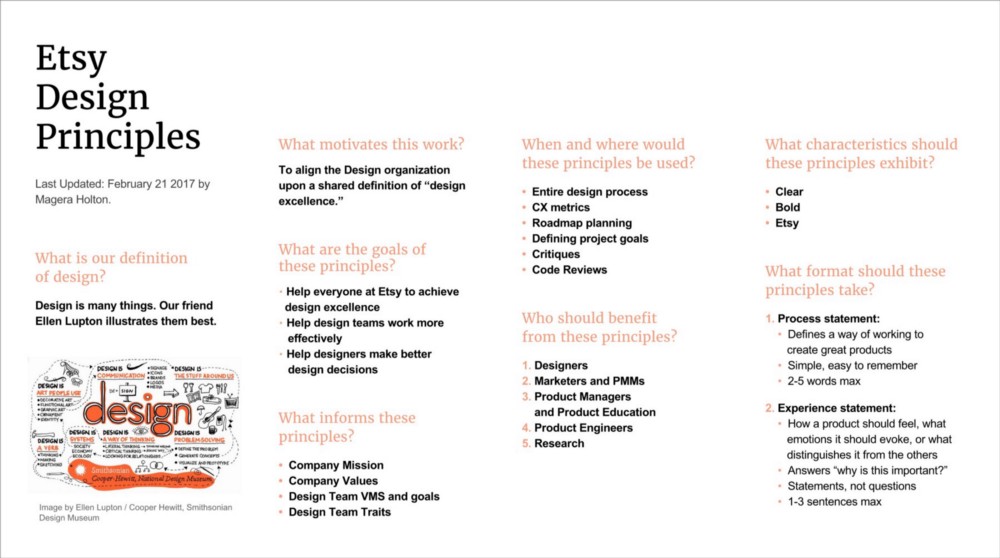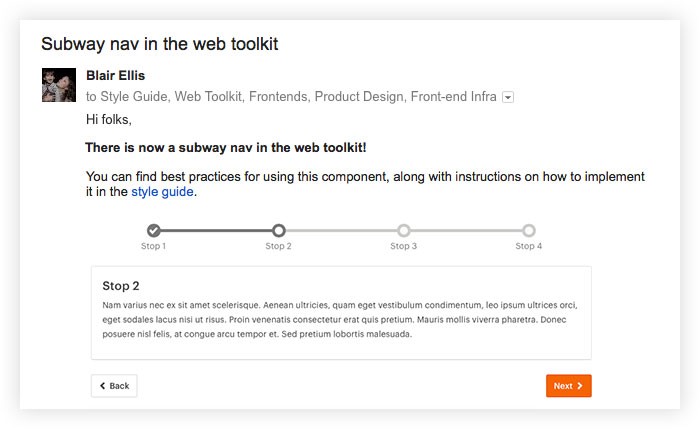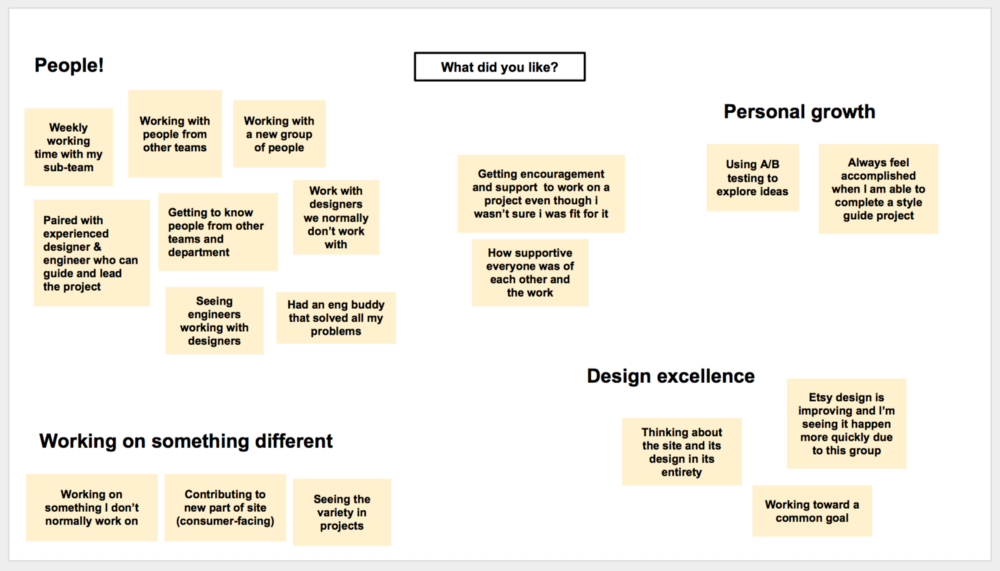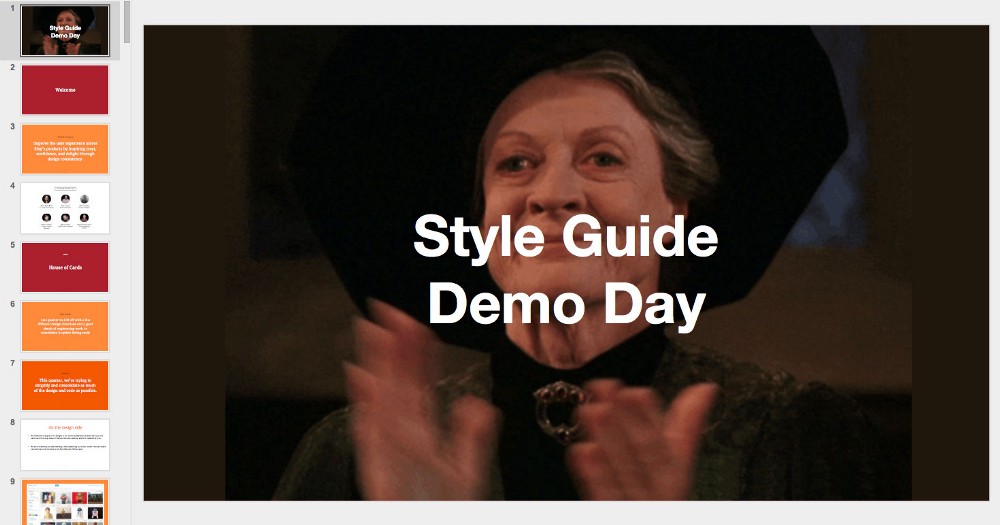Crafting an effective working group
At Etsy, some of the most interesting (and most difficult!) challenges we face as a design team don’t always have a clear or obvious owner. Our initiatives can span multiple product teams or even multiple disciplines. Without a dedicated team of people solving these problems, they’re easy to ignore.
One way that we try and tackle cross-team challenges at Etsy is by using working groups. A working group is a defined set of people, usually coming from multiple teams or disciplines, with a clear problem to overcome. Some have very specific goals and disband after a few months, others have existed over multiple years and evolved over time.
I’ve been involved in a number of design-focused working groups at Etsy, both in a leadership role and as a participant. I’ve seen things that work really well, and I’ve also seen them struggle to align and hit their goals. To help you set your working group up for success, I’ve put together some guidelines for organizing an effective one.
1. Establish a goal
First and foremost, working groups are created to solve a specific problem facing an organization. When the group is created, spend some time defining the goal. Since the problems you’re tackling can be broad and fuzzy, having an explicit goal can also help you decide what is and isn’t the responsibility of the group. Creating alignment on what the goal is will help you evaluate whether the group is successful down the line.
When the Design Team leads communicated our team-wide strategy of achieving “design excellence”, a lot of questions came up around what exactly “excellence” meant. To help answer those questions, the Design Principles working group was formed with the clear goal of creating design principles to define design excellence.

We reviewed the goals of the Design Principles working group at every meeting
Once you have a goal, make sure everyone understands it. Review the goal at the beginning of every meeting to remind group members of what they’re trying to achieve. Communicate the goal of the group broadly as a way to establish yourselves as the people dedicated to, and invested in, finding a solution.
2. Designate a facilitator
When the group is formed, the executive sponsor (or whichever leader establishes the group) should designate a facilitator. The facilitator runs meetings and keeps the group moving forward. Without a clear facilitator, meetings can become ineffective and group members won’t be held accountable for the work.
A facilitator’s job isn’t to say yes or no; sometimes the facilitator isn’t also the “decider”. Facilitation is more about making sure that progress toward goals is being made.
Facilitators are responsible for things like:
- Setting up meetings
- Making sure the meetings are effective
- Running on-time and inclusive meetings
- Setting the agenda for each meeting in advance
- Holding the group accountable to the executive sponsor
Oh, and the facilitator doesn’t have to be a manager; facilitation can be a great leadership opportunity for individual contributors. It gives ICs an opportunity to flex some organization and communication muscles in a different capacity than they might be used to in their day-to-day design work.
3. Define operations
Even though the work might not be a typical project with a typical team, it’s important to draw from the rituals of your other projects to make sure everything runs smoothly.
Working groups should have regularly scheduled meetings or collaborative work sessions to check in on progress, answer questions, and plan for future work. Meeting regularly will help remind group members of this work and give everyone face time with one another. If there’s any urgency to the work or a lot of smaller pieces to keep track of, it might even be helpful to add a weekly standup for status check-ins.
In addition to regular meetings, there should be ways for group members to communicate with one another in between meetings. At Etsy, we usually have a Google group and a Slack channel for informal, broad communication. These are also helpful channels for anyone outside of the group with a question to get in touch with working group members.
There may be other project rituals that your company uses, like Jira boards or wiki pages, that will help establish a smooth process. Use whatever communication and process tools you have at your disposal to set your group up for success.
4. Set milestones
Okay, so now you have the mission of the group, the facilitator, and some guidelines for operating. Time to start getting to work, right? Hold your horses.
One of the reasons I’ve seen working groups struggle to move forward and make progress is a lack of milestones.
Without clear milestones, it’s impossible to judge the pace at which you must work. This is especially true when the work is done on top of your regular workload. The worst thing that could happen to your working group would be that everyone chips away at the problem but never actually ships anything. In order to be effective, the group has to ship; in order to ship, milestones should be established from the beginning.
The Style Guide working group operated on a quarterly basis. At the beginning of each quarter, we kicked off a round of projects with the expectation that you’d be able to finish the work by the end of the quarter. Having a timeline helped designers scope their work; group members would only commit to doing projects they knew they could ship within a quarter.
The Design Principles working group set our sights on presenting the principles at the quarterly Design All Hands, since it would be a great time to reach every member of the design team. We ended up missing the deadline; we shared our progress and set a new deadline. And that’s okay. That milestone enabled us to work at a healthy pace; without it, we could easily have gone in circles without any incentive to move forward. Milestones can (and should!) change based on how progress is being made.
5. Operate transparently
Since the problems you’re solving can span your whole organization, chances are that other people outside of the group will be very invested in the work that the group does. To ensure the group isn’t working in a bubble or duplicating work, find ways to broadly share progress, get feedback, and operate transparently.
Some methods that we’ve used for creating transparency include:
- Creating a Slack channel
- Creating a Google Group
- Sending weekly update emails
- Creating open meetings
- Sending surveys

We frequently emailed relevant teams when there were important updates to the web toolkit
We maintained Etsy’s web toolkit through a working group in the early days. The web toolkit was rapidly being adopted by every product team, so there were a lot of people invested in our progress. Whenever we had new patterns, bug fixes, or major updates to functionality, we sent announcement emails across the company to make it easy for everyone to keep up with our progress.
Another way to operate transparently is to open up some or all of your meetings to everyone. The Style Guide group meetings were mandatory for anyone working on a quarterly project, but we wanted to give everyone a way to keep up with the work. We added teams invested in the work to our bi-weekly meeting invitation so they could pop in whenever they wanted.
Lastly, there might be ways to include people outside the working group. The feedback of the larger design team was critical to the success of the design principles. We sent surveys, conducted interviews, and ran critiques to get feedback from our target audience and stakeholders throughout the process. (Read more about our process here!) By the time we shared the final principles, everyone was well-informed and our stakeholders weren’t surprised.
It might feel counter-intuitive or spammy to send this info out widely, but sharing too much information is much better than leaving people who care about the work in the dark.
6. Evaluate your process
It’s important to evaluate and iterate on how you’re working together, especially since the work can be more ad-hoc than regular projects. Your time is precious; every little process improvement that you can make will have a big impact on the effectiveness of the group.

The Style Guide working group ran remote-friendly retrospectives to understand what was working well and what was challenging
One way that we evaluate our process at Etsy is to run retrospectives. The Style Guide working group was able to make huge improvements by running retrospectives regularly. One insight we uncovered was designers were rarely able to devote as much time to the work as they thought. This helped us encourage participants to keep projects small. Another insight was that participants didn’t realize until late in the quarter that they needed engineering help. The following quarter, we recruited engineers at the very beginning of projects.
Surveys are another way to get external feedback about your effectiveness. The web toolkit working group sent a few surveys to designers and engineers to ask about their use of the web toolkit, documentation, and pain points. This helped us get feedback on a larger scale and prioritize certain features.
7. Discuss the necessity of the group
The odds are high that you’re involved with the working group in addition to your day-to-day work. This extra work can really add up and occupy a lot of your time. You should feel comfortable having frank conversations about the group’s future.
Use your goal as a way to evaluate whether the group is still needed.
- Have you fixed the problem you set out to solve?
- Has the problem been solved another way?
- Has the company changed? Has its needs changed?
- Is the group still the most effective way to solve this problem?
Your group’s regular evaluations and retrospectives are the perfect opportunities to bring these questions up.
Since the Design Principles working group’s goal was to create a set of design principles, the group disbanded when the principles were written. The group may end up reforming in an entirely new shape, but the group as we knew it wasn’t necessary anymore.
The dissolution of a working group can be the result of processes and teams changing for the better. Our design leadership team made the case for having a team dedicated full-time to design systems by pointing to the success of the Style Guide working group. When the working group began to wind down, it was because we had a team of designers solving these hard problems full-time, and our existing process no longer made sense. In this case, the working group disbanding was a huge success!
8. Celebrate your victories
The best part of the Style Guide working group was the demo day at the end of the quarter. We invited multiple teams across Etsy, shared snacks and beverages, and watched as everyone demoed their hard work from the past few months. Seeing all of the work back-to-back felt so good; we really felt like we were making a huge impact on Etsy.

Style Guide demo days were a great way to celebrate our hard work
Demo days are just one way to celebrate work. Team-wide emails are a low-investment way to share progress and to give shoutouts to working group members. Regular team meetings like an All Hands can be an opportunity to give a quick plug for the working group and an overview of your progress. We’ve also used our Medium blog as a way to celebrate our work and share learnings outside of Etsy.
Whatever your company’s practices for recognition, make sure that your group takes the time to celebrate accomplishments. You’ve earned it!
So, in summary:
- Establish a goal
- Designate a facilitator
- Define operations
- Set milestones
- Operate transparently
- Evaluate your process
- Discuss the necessity of the group
- Celebrate your victories
Working groups can help your team solve complex, cross-functional problems. The nature of side projects means it’s crucial to design a structure that will set you up for success. Hopefully you can apply the lessons that we’ve learned along the way to solve some challenging problems in your own organization!
Thanks to Jason Huff and Jedediah Baker
This post originally appeared on Etsy Design’s Medium blog
Posted Jun 20, 2017